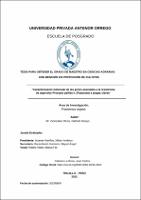Mostrar el registro sencillo del ítem
Caracterización molecular de los genes asociados a la resistencia de algarrobo Prosopis pallida k. (Fabaceae) a plagas claves
| dc.contributor.advisor | Cabrera La Rosa, Juan Carlos | |
| dc.contributor.author | Gonzales Deza, Gabriel Kenyo | |
| dc.creator | Gonzales Deza, Gabriel Kenyo | |
| dc.date.accessioned | 2022-08-29T01:12:58Z | |
| dc.date.available | 2022-08-29T01:12:58Z | |
| dc.date.issued | 2022 | |
| dc.identifier.uri | https://hdl.handle.net/20.500.12759/9407 | |
| dc.description.abstract | El algarrobo (Prosopis pallida) es una especie forestal perteneciente a la familia Fabaceae que se encuentra ampliamente distribuida por los departamentos de Ancash, La Libertad, Piura y Tumbes donde juega un rol muy importante a nivel ambiental,social y económico. No obstante,se ha venido produciendo un fenómeno que los especialistas han catalogado como el “declinamiento del algarrobo” cuyas causas se ven favorecidas principalmente por el cambio climático. Esto ha traído consigo que a nivel biótico aparezcan dos plagas claves (Heteropsylla texana y Enallodiplosis discordis) cuyos estragos favorecen en demasía con este problema. En tal sentido, se realizó una búsqueda en las bases de datos biológicos de NCBI y Uniprot de los genes y proteínas asociados a la resistencia del algarrobo a plagas claves. Los resultados indican que a nivel de la subfamilia Caesalpinioideae existen nueve grupos de proteínas relacionadas con la resistencia natural de las plantas (ureasas, fosfolipasas A2, aleno óxido sintasas, inhibidores de amilasas, lipoxigenasas, glutatión S-transferasas, inhibidores de tripsina, lectinas y peroxidasas) y que la especie más cercana a P. pallida donde se han reportado proteínas entomotóxicas es Prosopis juliflora, sugiriendo de este modo que estas proteínas pueden ser utilizadas como marcadores moleculares a fin de seleccionar plantas elites de manera temprana que puedan responder mejor al ataque de H. texana y E. discordis. | es_PE |
| dc.description.abstract | The Prosopis tree (Prosopis pallida) is a forest species belonging to the Fabaceae family that is widely distributed throughout the departments of Ancash, La Libertad, Piura and Tumbes, where it plays a very important role at environmental, social and economic level. However, a phenomenon has been taking place that specialists have classified as the ““decline of the Prosopis tree““ whose causes are mainly favored by climate change. This has brought about the appearance of two key pests at the biotic level (Heteropsylla texana and Enallodiplosis discordis) whose breakouts enhances this problem. In this sense, a search was made in the biological databases of NCBI and Uniprot of the genes and proteins associated with the resistance of the Prosopis tree to key pests. Thus, at the level of the Caesalpinioideae subfamily, it was found that there are 9 groups of proteins related to the natural resistance of plants (ureases, phospholipases A2, allene oxide synthases, amylase inhibitors, lipoxygenases, glutathione S-transferases, trypsin inhibitors, Lectins, Peroxidases) and that the closest species to P. pallida where entomotoxic proteins have been reported is Prosopis juliflora, thus suggesting that these proteins could be used as molecular markers in order to select elite plants early so that they can respond better to the attack of H. texana and E. discordis | en_US |
| dc.description.uri | Tesis | es_PE |
| dc.format | application/pdf | es_PE |
| dc.language.iso | spa | es_PE |
| dc.publisher | Universidad Privada Antenor Orrego | es_PE |
| dc.relation.ispartofseries | T_MAEST.AGRA_011 | |
| dc.rights | info:eu-repo/semantics/openAccess | es_PE |
| dc.rights.uri | https://creativecommons.org/licenses/by/4.0/ | es_PE |
| dc.source | Universidad Privada Antenor Orrego | es_PE |
| dc.source | Repositorio Institucional - UPAO | es_PE |
| dc.subject | Prosopis Pallida | es_PE |
| dc.subject | Prosopis Juliflora | es_PE |
| dc.title | Caracterización molecular de los genes asociados a la resistencia de algarrobo Prosopis pallida k. (Fabaceae) a plagas claves | es_PE |
| dc.type | info:eu-repo/semantics/masterThesis | es_PE |
| thesis.degree.level | Maestría | es_PE |
| thesis.degree.grantor | Universidad Privada Antenor Orrego. Escuela de Postgrado | es_PE |
| thesis.degree.name | Maestro en Ciencias Agrarias con Mención en Protección de Cultivos | es_PE |
| thesis.degree.discipline | Maestría en Ciencias Agrarias | es_PE |
| dc.subject.ocde | https://purl.org/pe-repo/ocde/ford#4.00.00 | es_PE |
| renati.advisor.orcid | https://orcid.org/0000-0002-8236-3352 | es_PE |
| renati.author.dni | 48383424 | |
| renati.advisor.dni | 08784027 | |
| renati.type | https://purl.org/pe-repo/renati/type#tesis | es_PE |
| renati.level | https://purl.org/pe-repo/renati/level#maestro | es_PE |
| renati.discipline | 811247 | es_PE |
| renati.juror | Huanes Mariños, Milton Américo | |
| renati.juror | Barandiarán Gamarra, Miguel Ángel | |
| renati.juror | Robles Pastor, Blanca Flor | |
| dc.publisher.country | PE | es_PE |


